October - December 1998
Table of Contents
|
To help take best advantage of its new computers, the ISC has hired
an experienced system administrator. James Harris holds an honours
degree in physics from the University of Manchester. Since earning
his B.Sc. in 1991, James has worked in the electronics hardening
division of the UK Atomic Weapons Establishment (AWE). There, James
developed and maintained computer applications using a wide variety of
numerical algorithms. More recently with AWE, he was responsible for
administering his group's DEC computer and PCs, running Unix and
Windows operating systems.
In addition to administering the Sun workstations, James has primary
responsibility for installing and configuring the Oracle database
management system at the ISC. "This a great opportunity gain
experience with state-of-the-art information technology," says James.
"I'm eager to put the skills that I've learned at AWE to use in a
challenging new way."
James has his hands full just now with two further Sun workstations
that arrived in December, bringing the Centre's total to seven. Each
staff member is now equipped with a PC or workstation.
|
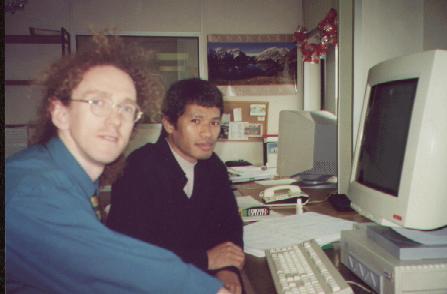
The Centre's newest employees, seismologist Mamy Andrianirinna
and system administrator James Harris, discuss configuration of
Mamy's Sun workstation.
|
The US National Science Foundation has provided supplementary funding
to accelerate development of ISC software. The supplement is for the
salary of a developer for one year, concentrating on improving
automatic association of readings with earthquakes. An extra developer
should also help to free up the time of other staff members to develop
tools for interactive editing. For both projects, a relational
database is an important tool to implement effective new programs
quickly.
Dr Igor Chernobay, Operations Manager at the Provisional International
Data Centre in Vienna, visited the ISC in November. The Provisional
IDC is part of the Provisional Technical Secretariat (PTS), which is
building the system to monitor the Comprehensive Test Ban Treaty. Dr
Chernobay's group plans a bulletin of its analysis beginning in August
1999, progressively replacing that of the Prototype IDC in Arlington,
USA.
Dr Chernobay was in the UK as a member of a delegation that included
Mr Wolfgang Hoffmann, Secretary General of the PTS. Working together,
the IDC and the ISC could each provide greater benefits to their
users, including a more comprehensive Bulletin. At a meeting in
London, ISC Director Ray Willemann discussed the advantages of
co-operation with Mr Hoffmann and Dr Chernobay. Partly as an outcome
of this meeting and Dr Chernobay's visit, several new activities are
underway. Initially, the ISC is sending the IDC a monthly letter to
briefly compare the IDC and ISC locations for common events. In
addition, the IDC and ISC plan to co-ordinate development of data
exchange formats that meet the needs of both organisations.
Plans for GSN Readings
Digitally recorded broadband data from the Global Seismic Network are
routinely archived at the IRIS Data Management Center (DMC). Despite
extensive investment in operating these stations and archiving and
distributing the data, many of the station records are not routinely
read. Starting over the last several months, the quality assurance
procedures of the IRIS Data Collection System have been modified to
carefully review records of large earthquakes.
While visiting the DMC, Ray Willemann worked with Bob Woodward of the
Albuquerque Seismic Laboratory and Ken Creager of the University of
Washington to alter these reviews so that readings can be reported to
the ISC. These large events are already among those with the most
precise locations in the Bulletin. But the additional GSN readings
will include amplitudes and later phases, which are reported less
often, but useful for a variety of earth structure studies. In
addition, Ray and DMC Director Tim Ahern discussed working
co-operatively to develop CORBA-compliant object classes for seismic
data.
|
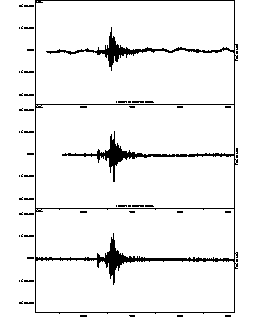
Albuquerque Seismic Lab is using their Windows program
"DIMAS" to read GSN records that will be sent to the ISC.
|
|
More people than ever obtained data from the ISC web site during the
last quarter of 1998. The number of visitors began climbing with the
start of the new academic year, and the average number of on-line
Bulletin searches grew from 120 in August to 380 in November and early
December. Many searches are for recent data, some not yet been
released on CD, but two-thirds of queries are for events from before
1990.
Currently, users can search over time periods spanning several
calendar months only by repeating otherwise identical queries. New
tools to streamline this frequently used search pattern are planned
within a few months, after the complete Catalogue from 1964 is loaded
into a relational database.
|
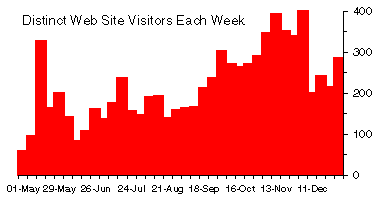
|
The ISC has implemented a new programme to track the effort devoted to
each stage of editing the Bulletin. ISC seismologists recognise that
some months are much more difficult due to large aftershock sequences
or other circumstances. At the same time, there is a steady increase
in the average editing load due to the receipt of more data. Tracking
will aid decisions on software development, including tools for
on-line editing.
One early surprise is that during the first few months ISC
seismologists have spent less than 10% of their time reviewing the
outcome from "Search". Search is the ISC's process to generate new
event hypotheses from readings that cannot be associated with reported
hypocentres. Over 95% of the events in the Bulletin are from events
previously located by regional agencies using subsets of the data
available at the ISC. It had been thought that Search events require
an inordinate fraction of editing time, and the value of the effort
has been questioned. Many Search events may have been previously
located, but assigned magnitudes falling below a threshold for
reporting to the ISC. Tracking sets a benchmark for the performance
of alternative event formation algorithms.
Magnitudes Assessed
From year to year, there are changes in the mix of stations that
contribute amplitudes used to compute magnitudes at the ISC. How much
does this changing mixture influence the magnitudes? The question is
of special importance in comparing magnitudes from different years
during the 1990's, as the GSETT-3 experiment starting in 1995 may have
had a singular influence on magnitudes. Half of mb amplitudes in the
1995 ISC Bulletin are from stations that participated in GSETT-3
which, on average, had station mb values 0.3 units smaller than other
stations.
Ray Willemann addressed this question in talks at the Prototype IDC,
Lamont-Doherty Earth Observatory and the American Geophysical Union
meeting in December. He showed that while the GSETT-3 stations
influenced 1995 ISC mb values, the same set of stations was important
before 1995 and had similar effects in earlier years. What's more,
some other sets of stations had even larger, if less widespread,
effects. Surprisingly, some individual GSETT-3 stations turn out to
have systematically high station magnitudes, in contrast to the
network average. Questions remain about magnitudes, but the GSETT-3
influence was not unique. Those requiring accurate comparisons of
magnitude must take careful account of the influence of data selection
in all cases. Slides presented at the meeting are available
on the ISC web site
here.
|
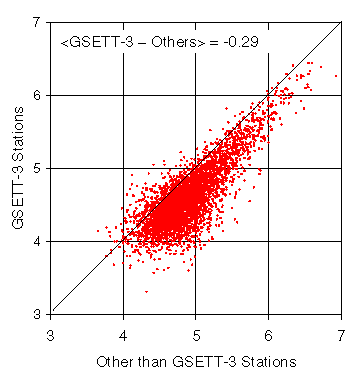
Bulletin mb values are systematically lower than they
would be if GSETT-3 amplitudes were excluded.
|
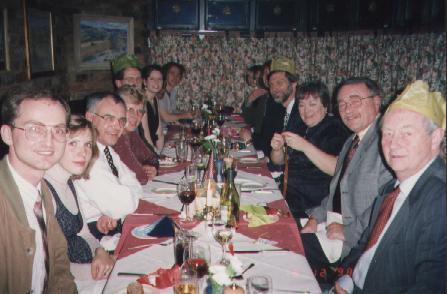
The ISC and their families wish all of our community happy
holidays.
国产精品无码免费专区午夜_精品无码国产一区二区三区51安_AV无码久久久久不卡蜜桃_在线观看片免费人成视频无码
色一情一乱一伦一区二区三区日本|
毛片在线播放视频|
日韩日韩日韩日韩日韩|
麻豆一区二区三区视频|
公共露出暴露狂另类av|
亚洲国产精品久久久久爰色欲|
www.国产视频.com|
日本手机在线视频|
国产免费中文字幕|
国产日产欧美视频|
成人区一区二区|
亚欧美一区二区三区|
日韩精品一区中文字幕|
免费高清一区二区三区|
福利网在线观看|
污污的视频免费|
欧美日韩亚洲一二三|
国产九九九九九|
欧美一二三不卡|
成人不卡免费视频|
男人舔女人下面高潮视频|
日韩一级性生活片|
吴梦梦av在线|
在线观看av免费观看|
色戒在线免费观看|
国产视频在线视频|
欧美亚洲黄色片|
波多野结衣网页|
欧美另类videosbestsex日本|
天堂在线一区二区三区|
黄色国产小视频|
日本三级免费观看|
凹凸国产熟女精品视频|
国产妇女馒头高清泬20p多|
xxxxxx在线观看|
亚洲欧美日韩不卡|
午夜在线视频免费观看|
在线视频观看91|
国产自偷自偷免费一区|
成年人视频网站免费观看|
无码粉嫩虎白一线天在线观看
|
午夜免费高清视频|
av动漫免费看|
国产成人无码a区在线观看视频|
青青草国产免费|
免费日韩在线观看|
久操手机在线视频|
免费拍拍拍网站|
分分操这里只有精品|
僵尸世界大战2 在线播放|
你懂的av在线|
男人操女人免费软件|
黄色高清无遮挡|
99热这里只有精品在线播放|
日本特黄a级片|
亚洲综合婷婷久久|
九九热视频免费|
欧美一级免费在线观看|
欧美 亚洲 视频|
蜜桃传媒一区二区三区|
777米奇影视第四色|
九色91popny|
亚洲一二区在线观看|
成人黄色一级大片|
黄色片视频在线播放|
亚洲免费一级视频|
国产又粗又猛大又黄又爽|
久久福利一区二区|
国产妇女馒头高清泬20p多|
日韩免费视频播放|
免费无码国产v片在线观看|
中文字幕 91|
中国老女人av|
免费毛片网站在线观看|
精品视频无码一区二区三区|
亚洲欧美国产中文|
女同性恋一区二区|
日韩欧美国产免费|
欧美日韩中文不卡|
天堂av在线中文|
无码aⅴ精品一区二区三区浪潮|
五月婷婷之综合激情|
一级全黄肉体裸体全过程|
亚洲 欧美 日韩 国产综合 在线|
成人黄色一区二区|
成人在线观看毛片|
国产精品免费成人|
熟女视频一区二区三区|
av天堂永久资源网|
国产一区一区三区|
黑鬼大战白妞高潮喷白浆|
伊人国产精品视频|
99热在线这里只有精品|
蜜桃福利午夜精品一区|
国产精品69久久久|
天堂视频免费看|
大伊香蕉精品视频在线|
爱爱爱爱免费视频|
av免费观看国产|
五月六月丁香婷婷|
黄色网页免费在线观看|
男女啪啪的视频|
久草精品在线播放|
国产精品免费看久久久无码|
国产又粗又长又大的视频|
97超碰在线人人|
www.日本久久|
无码人妻精品一区二区三区66|
成人在线免费观看视频网站|
九九热在线免费|
欧美在线观看www|
九九久久九九久久|
91女神在线观看|
激情五月开心婷婷|
农民人伦一区二区三区|
深夜做爰性大片蜜桃|
在线看的黄色网址|
日本三级免费网站|
无码日本精品xxxxxxxxx|
校园春色 亚洲色图|
av动漫在线看|
成人免费看片'免费看|
91性高潮久久久久久久|
青青草av网站|
男人揉女人奶房视频60分
|
日韩网站在线免费观看|
手机精品视频在线|
青青草原av在线播放|
国产欧美久久久久|
亚洲精品一二三四五区|
av一区二区三区免费观看|
成 人 黄 色 小说网站 s色|
免费毛片小视频|
丰满少妇久久久|
国产肉体ⅹxxx137大胆|
久久久一二三四|
一女二男3p波多野结衣|
超碰网在线观看|
青娱乐自拍偷拍|
美女扒开大腿让男人桶
|
黄色一级免费大片|
久久久精品在线视频|
亚洲人成无码网站久久99热国产|
国产高清不卡无码视频|
天天操天天干天天玩|
五月婷婷六月丁香激情|
www日韩视频|
久久精品午夜福利|
男女高潮又爽又黄又无遮挡|
av日韩一区二区三区|
人体内射精一区二区三区|
69sex久久精品国产麻豆|
97超碰国产精品|
免费观看亚洲视频|
avove在线观看|
午夜免费福利视频在线观看|
日韩大片一区二区|
亚洲老女人av|
亚洲36d大奶网|
五月天中文字幕在线|
香港日本韩国三级网站|
91人人澡人人爽人人精品|
国产精彩免费视频|
色婷婷狠狠18|
av亚洲天堂网|
青少年xxxxx性开放hg|
www.男人天堂网|
国产视频九色蝌蚪|
九一精品在线观看|
亚洲一二三不卡|
国产xxxxhd|
欧美中日韩在线|
国产午夜伦鲁鲁|
亚洲精品高清无码视频|
国产精品自拍视频在线|
婷婷视频在线播放|
国产精品国产三级国产专区51|
成人黄色av片|
国产精品亚洲a|
亚洲欧美日韩精品一区|
亚洲男人天堂2021|
日韩成人午夜影院|
国产极品在线视频|
色综合天天色综合|
欧美日韩视频免费在线观看|
日本一级黄视频|
成人在线免费观看av|
玖玖爱视频在线|
轻点好疼好大好爽视频|
国产xxxxx在线观看|
午夜视频在线观|
分分操这里只有精品|
超碰影院在线观看|
caoporm在线视频|
国产一线二线三线女|
国产天堂在线播放|
艳母动漫在线免费观看|
www黄色日本|
亚洲黄色av片|
日韩 欧美 视频|




